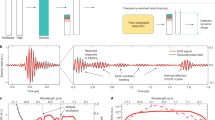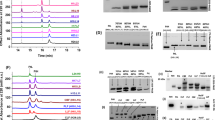Abstract
IT is well known that the various vertebrate haemoglobins as well as the individual variants of adult human haemoglobin (Hb A) may be readily distinguished by their different mobility in electrophoresis, adsorbability and stability to thermal denaturation. A possibility of identification, particularly in abnormal haemoglobins, is offered by recombination analysis and, finally, by the determination of the amino-acid composition and sequence. We found the ultra-violet spectrum as recorded between 39,000 and 34,000 cm−1 provided a very simple additional means of differentiation. Little information can be obtained from the literature1,3,4. Hb F (foetal human haemoglobin) may be recognized from its well-distinguishable tryptophan band at 34,400 cm−1, and Matsuda4 directed attention to the absorption differences between the human α-, β-and γ- chains. If the ultra-violet spectrum is recorded at high resolution using an appropriate haemoglobin derivate, however, many more differentiated results may be achieved.
This is a preview of subscription content, access via your institution
Access options
Subscribe to this journal
Receive 51 print issues and online access
$199.00 per year
only $3.90 per issue
Buy this article
- Purchase on Springer Link
- Instant access to full article PDF
Prices may be subject to local taxes which are calculated during checkout
Similar content being viewed by others
References
Jope, E. M., Haemoglobin Symposium (Butterworth Sci. Publ., London, 1949).
Leach, S. I., and Scheraga, H. A., J. Biol. Chem., 235, 2827 (1960).
Lemberg, R., and Legge, J. W., Hematin Compounds and Bile Pigments (Interscience Pub., Inc., New York, and London, 1949).
Matsuda, G. T., Maekawa, T., and Muta, I., Hoppe Seyler's Z. Physiol. Chem., 331, 295 (1963).
Perlman, G. E., J. Biol. Chem., 239, 3762 (1964).
Whitney, P. L., and Tanford, C., J. Biol. Chem., 237, PC, 1735 (1962).
Wishnia, A., and Pinder, T., Biochemistry, 3, 1377 (1964).
Yanari, S., and Bovey, F. A., J. Biol. Chem., 235, 2818 (1960).
Bencze, W. L., and Schmid, K., Anal. Chem., 29, 1193 (1957)
Author information
Authors and Affiliations
Rights and permissions
About this article
Cite this article
JUNG, F., STOPP, G. & RUCKPAUL, K. Ultra-violet Absorption Spectra of Haemoglobins from Various Vertebrates. Nature 207, 990–991 (1965). https://doi.org/10.1038/207990a0
Issue Date:
DOI: https://doi.org/10.1038/207990a0
Comments
By submitting a comment you agree to abide by our Terms and Community Guidelines. If you find something abusive or that does not comply with our terms or guidelines please flag it as inappropriate.



